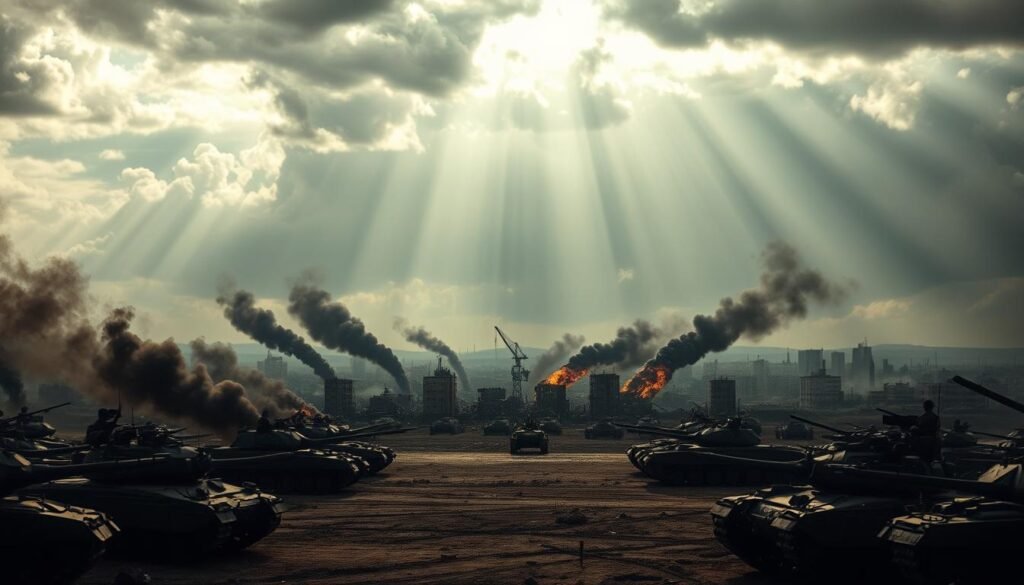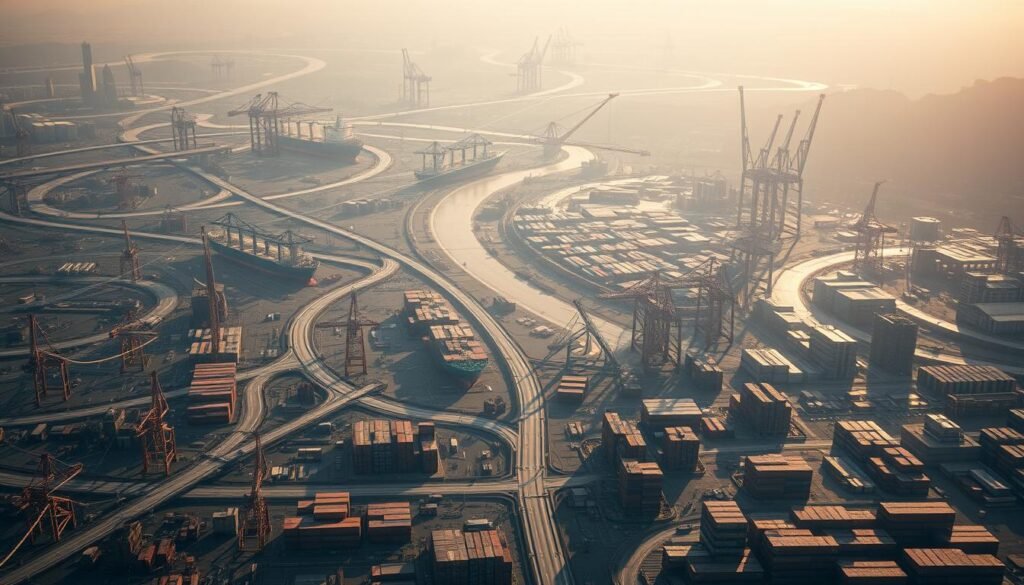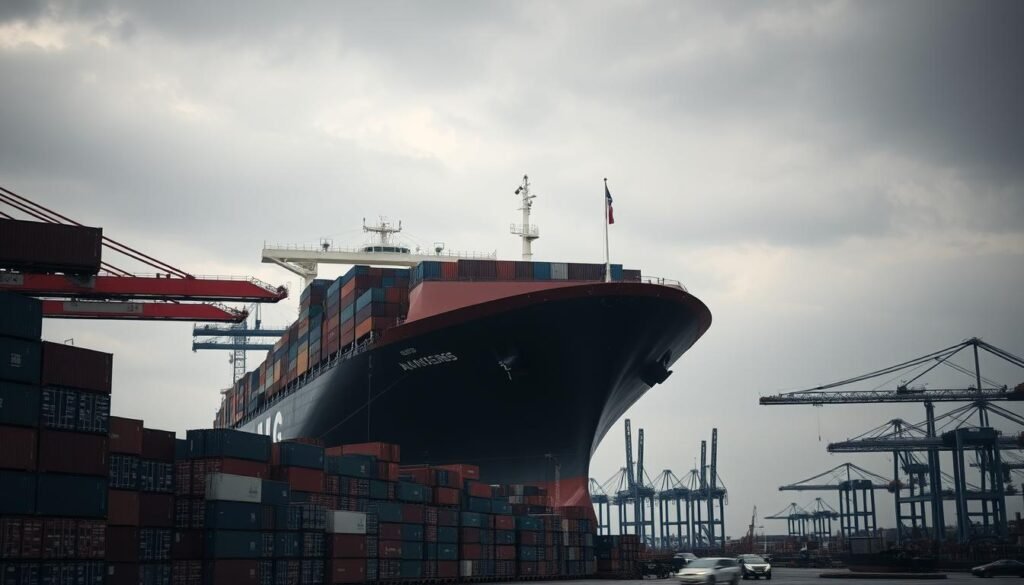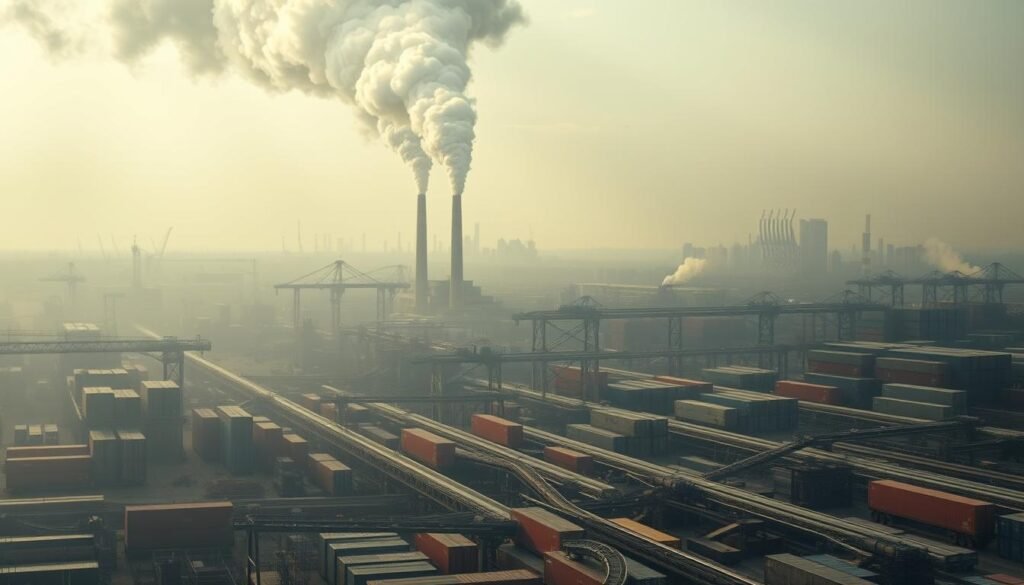Global Economic Fallout: The Impact on Oil Prices, Supply Chains, and Inflation
Did you know the COVID-19 pandemic caused a huge economic crisis? It made the world economy shrink by 3.5% in 2020. This shows how big impacts from unexpected events can affect economies all over the world. We’ll look at how this crisis affects oil prices, supply chains, and inflation.
The global economy is very connected. Problems in one area can cause big issues elsewhere. In this article, we’ll explore how the recent global recession and supply chain problems are affecting oil prices and inflation. Knowing these things helps us understand today’s financial world better.
Key Takeaways
- The COVID-19 pandemic led to a 3.5% contraction in the global economy in 2020.
- Global crises significantly impact oil prices and contribute to broader economic instability.
- Understanding the causes and effects of supply chain disruptions is key to finding solutions.
- Inflation is closely tied to global supply chain health and oil price changes.
- Proactive strategies can help lessen the economic impact on industries and markets.
Introduction to Global Economic Fallout
The global economy is very connected. Problems in one area can affect many others. This can happen due to political issues, economic troubles, or natural disasters. It’s called economic fallout.
It’s important to know how financial troubles can spread. This affects things like oil prices, supply chains, and inflation.
Defining Economic Fallout
Economic fallout is when big problems cause trouble in the economy. It can lead to changes in trade, investment, and jobs. This unexpected trouble can make financial issues worse in different areas.
Looking at past events like the 2008 crisis or COVID-19 helps us see how these problems affect the world.
The Relevance of Economic Fallout in Today’s World
In today’s world, economic fallout is very important. As economies get more connected, problems in big countries can affect others. For example, the US-China trade war or Brexit.
Financial troubles in one place can quickly spread. This can impact markets, investments, and daily business around the world. So, understanding economic fallout is key for those trying to deal with the global economy’s challenges.
The Influence of Geopolitical Tensions on Oil Prices
Geopolitical tensions greatly affect global oil prices, causing uncertainty and market volatility. These tensions arise from international conflicts and strategic moves. Let’s look at two key examples that show how these tensions work.

Case Study: Russia-Ukraine Conflict Impact
The ongoing conflict between Russia and Ukraine has a big impact on oil prices worldwide. Russia, a major oil and gas player, has disrupted the supply chain. This has led to oil price shocks due to sanctions and countermeasures.
These disruptions cause price swings that affect economies globally.
China’s Role in Global Oil Supply
China is a huge player in the oil world, both as a consumer and producer. Any tensions involving China can shake the global oil market. China’s alliances and trade practices can either keep prices stable or cause them to fluctuate.
- China’s significant consumption of oil means any supply chain issues can quickly affect markets.
- China’s ability to produce oil also lets it control global supply levels, impacting price stability.
- China’s economic policies and geopolitical stance are key indicators for the global energy market.
Understanding the effects of geopolitical tensions on oil prices is key to predicting market trends. By studying cases like the Russia-Ukraine conflict and China’s role, we learn about the complex forces shaping oil prices.
Oil Price Shocks and Global Inflation
Oil price shocks have a big impact on global inflation. Changes in oil prices affect many areas of the economy. This includes production costs and consumer prices, leading to market downturns.
Historic Trends and Current Analysis
In the past, oil price shocks have caused high inflation. The 1970s oil crises led to high inflation worldwide. This happens because higher oil prices raise production costs. Companies then charge more to consumers.
Recently, we’ve seen similar effects. The 2008 financial crisis and high oil prices caused a big market downturn. Today, geopolitical tensions and supply chain issues keep oil prices volatile, affecting inflation.
Short-term vs. Long-term Impacts
It’s important to look at the short-term and long-term effects of oil price shocks. Short-term, sudden price increases cause inflation as costs for transport and manufacturing go up. This makes goods and services more expensive for consumers.
But the long-term effects are more complex. Long periods of high oil prices can slow down the economy. This can lead to less spending by consumers and slower growth. Over time, economies might turn to alternative energy or more efficient technologies to deal with future price shocks.
Understanding Supply Chain Disruptions
The world has seen many supply chain disruptions in recent times. These have affected many industries. They come from things like wars, pandemics, and natural disasters. We will look at the big disruptions and their economic effects.
Major Disruptions in Recent Times
Supply chain problems have gotten worse and more common. The COVID-19 pandemic, Brexit, and the Suez Canal blockage have all had big effects. They have caused big delays and cost increases in the global supply chain.
Quantitative Analysis of Supply Chain Disruptions
We looked at the economic effects of these disruptions. We looked at delayed shipments, higher transport costs, and stopped production. This helps us understand how wide and deep these problems are.
| Event | Industry Impacted | Economic Impact | Duration |
|---|---|---|---|
| COVID-19 Pandemic | Healthcare, Automotive, Technology | $Trillions | Ongoing |
| Suez Canal Blockage | Shipping, Retail | $9.6 Billion/day | 6 days |
| Brexit | Agriculture, Manufacturing | $Hundreds of Billions | Long-term |
Our study shows that supply chain problems have big effects. They go beyond just delays to affect the whole economy. Knowing about these problems and their numbers is key to understanding their long-term effects.
Global Supply Chain Pressure Index (GSCPI)
The Global Supply Chain Pressure Index, or GSCPI, is a key tool for understanding global supply chain challenges. It combines data from all over the world to show the big issues in supply chains. This helps us see the problems facing different industries.

Development and Usage
The Global Supply Chain Pressure Index was made by using data from major economies. It uses advanced methods to measure supply chain problems. Companies and leaders use it to make smart choices based on up-to-date information.
Sectoral Impacts of GSCPI
The GSCPI affects many sectors deeply. It shows how different industries face global and local issues. This helps in making plans to reduce pressure and build strength in each area.
| Sector | Impact Level | Key Challenges |
|---|---|---|
| Automotive | High | Component shortages, logistics delays |
| Electronics | Moderate | Semiconductor scarcity, increased demand |
| Retail | Low | Inventory management, consumer shifts |
Impact of Global Economic Fallout on the Stock Market
When the global economy is uncertain, the stock market often swings sharply. These swings show what investors think and the state of the market. We see both bearish and bullish reactions during these times.
Bearish Market Reactions
Financial instability can make markets very volatile. A stock market crash is often feared. Investors quickly sell assets, expecting earnings to drop and the economy to slow down.
This panic selling can cause big drops in stock prices. These drops make financial instability worse.
Events like the 2008 financial crisis show how fast market mood can change. This leads to long periods of market pessimism and bearish trends. These changes are mainly due to bad economic signs and less investor confidence.
Bullish Market Reactions
But sometimes, global economic problems lead to a bullish reaction. Investors might think governments will step in with help. This could be in the form of stimulus packages or lower interest rates.
Some sectors might also see benefits from these changes. This can attract more investment.
It’s key for investors and policymakers to watch these market moves closely. Knowing if the market is bearish or bullish helps make better decisions. It helps avoid the worst of a stock market crash and deal with financial instability.
Role of Energy Prices in Shaping Inflation
Energy prices greatly affect inflation. They are key to industrial production, touching many parts of the economy. This includes consumer prices, production costs, and inflation rates. By looking at how energy prices and the economy interact, we can see their strong connection to inflation.
Energy Sector’s Contribution to Inflation
The energy sector is a big player in inflation. When energy prices go up, production costs rise. Producers then charge more to consumers. This can also raise transportation costs, affecting the prices of goods and services.
In short, the energy sector is a major force behind inflation worldwide.

Case Study: Phillips and East Asian Economies
The Phillips Curve shows how inflation and unemployment are linked. It’s very important for East Asian economies. In places like Japan and South Korea, energy prices have a big impact on inflation.
For example, quick changes in energy prices can move the Phillips Curve. This means higher inflation without a change in unemployment. Knowing this helps policymakers manage inflation better, even when energy prices change a lot.
Oil Prices During Economic Crises
It’s important to understand how oil prices and economic crises are connected. These crises have a big impact on oil prices. In turn, oil prices affect many economic factors around the world.
Historical Perspective: From 1970 to Present
Oil prices have followed a cycle for decades, often because of economic crises. For example, the 1973 oil embargo made prices quadruple, causing big economic problems. The 2008 financial crisis also had a big effect, making oil prices drop from over $140 to under $40.
“Economic crises and oil prices are inextricably linked. The fluctuations in the global economy invariably influence the oil markets, often with sweeping repercussions.”
Future Projections
Experts think oil prices will keep being unpredictable because of economic crises. The COVID-19 pandemic showed this, with prices falling then rising as the economy recovered.
By looking at past trends, we can guess how future economic crises will affect oil prices. It’s key to plan ahead and take steps to lessen the negative effects on the global economy.
Economic Downturns and Trade Disruptions
In the world of global trade, economic downturns can cause big problems. These issues spread across many areas, hitting supply chains and manufacturing hard. This makes it tough to keep the economy stable.
Supply Chain Reaction to Trade Disruptions
The global supply chain is very sensitive to trade issues. Economic downturns can mess up the flow of goods and services. This leads to delays and higher costs.
For example, the 2008 global financial crisis caused big problems for many industries. They faced severe supply chain bottlenecks.
During times of economic trouble, companies find it hard to keep their supply chains running smoothly. This leads to backlogs and less efficiency.

Businesses need to rethink their logistics plans during these times. They often switch to more flexible and strong supply chain models. This can greatly affect trade efficiency, making economic troubles worse.
Effects on Manufacturing Industries
Manufacturing is very sensitive to trade issues. Economic downturns mean less demand and less money to invest. This directly affects how much is produced.
In 2020, the COVID-19 pandemic messed up manufacturing supply chains worldwide. It caused delays and shortages in important products.
- Decreased Production: Economic downturns mean fewer orders for manufacturers. They have to cut back, affecting jobs and income.
- Increased Costs: Raw materials and transport costs go up during disruptions. This adds to the financial stress on manufacturers.
- Market Volatility: Trade issues make markets unpredictable. This causes uncertainty and loses investor trust.
The mix of economic downturns and trade disruptions is a big challenge for manufacturing worldwide. To tackle these issues, companies need quick and strong plans to stay resilient.
Financial Instability Linked to Supply Chain Issues
Financial troubles are a big worry for businesses worldwide. They are closely linked to ongoing supply chain problems. Supply chains are complex, and issues can spread across industries. This affects companies’ financial health in many ways.
Impact on Firm’s Financial Health
Supply chain problems lead to higher costs, lost sales, and shaky stock prices. Delays, higher shipping costs, or material shortages are common causes. These issues hurt global markets’ financial stability.
For example, longer lead times can mean idle factories and lost income. This shows how supply chain troubles can harm a company’s finances.
Also, supply and demand mismatches have caused price hikes in many areas. Companies must find new ways to get what they need, which can be expensive. This highlights how supply chain problems lead to financial instability.
Case Study: Chinese Stock Market
The Chinese stock market is a good example of how supply chain issues affect the economy. In recent years, tech and manufacturing sectors have seen downturns due to supply chain problems. These problems often come from trade issues or strict rules.
When supply chain troubles hit, the Chinese stock market gets very volatile. For example, the chip sector faced big disruptions, leading to a drop in stock prices. This shows how financial instability can follow supply chain problems.
| Year | Sector | Supply Chain Issue | Impact on Stock Prices |
|---|---|---|---|
| 2020 | Technology | Semiconductor Shortage | -15% |
| 2021 | Manufacturing | Port Congestion | -10% |
| 2022 | Consumer Goods | Logistics Delays | -8% |
Inflation Driven by Supply Chain Disruptions
Inflation is a big economic problem today, mainly because of supply chain issues. These issues make it hard to get goods and services, leading to higher costs. This means prices for things like food and electronics go up.
Supply chain problems really hit consumer prices hard. When it’s hard to get materials or products, businesses pay more. They then raise prices, adding to inflation. For instance, the car industry has seen big price jumps because of a chip shortage.
Investors are also changing their strategies because of inflation worries. They look for things like real estate and commodities that keep up with inflation. This shows how wide-reaching supply chain issues are, affecting both the market and financial areas.
| Sector | Impact | Example | Outcome |
|---|---|---|---|
| Automotive | High | Chip Shortages | Increased Car Prices |
| Electronics | Moderate | Component Scarcity | Delayed Product Launches |
| Retail | Moderate | Logistics Delays | Stockouts |
| Food & Beverage | High | Raw Material Shortages | Price Increases |
It’s key to understand how inflation and supply chain issues are connected. Businesses, policymakers, and consumers need to plan carefully to deal with these problems. This helps keep the economy stable.
Comparative Analysis of Different Economic Sectors
Each economic sector faces different levels of risk from supply chain disruptions. This is because of their unique ways of working and what they need to keep running. Knowing these differences is key to making strong plans to handle these risks.
Sector-specific Sensitivity to Supply Chain Disruptions
The sensitivity to supply chain disruptions varies across sectors. For example, manufacturing and healthcare are very sensitive. They need raw materials and key parts on time. On the other hand, tech services are more resilient. They focus on digital work and don’t need as many physical items.
| Economic Sector | Sensitivity Level | Reasons for Sensitivity |
|---|---|---|
| Manufacturing | High | Dependence on raw materials and just-in-time delivery |
| Healthcare | Moderate to High | Reliance on critical medical components and pharmaceuticals |
| Technology Services | Low to Moderate | Mainly digital operations with minimal physical goods dependency |
| Retail | Moderate | Vulnerability due to dependency on global supply chains |
Strategies to Mitigate Risks
To reduce supply chain risks, companies can take several steps. One effective method is to diversify their suppliers. This way, they’re not too dependent on one supplier and can better handle disruptions. Using advanced tech like AI and blockchain is also helpful. It helps predict problems and makes the supply chain more open.
Keeping extra inventory is another good strategy. It acts as a safety net during tough times. Working closely with suppliers is also important. This way, risks can be shared, and the supply chain stays strong.
By using these strategies, businesses in all sectors can become more resilient. They can better handle supply chain disruptions and keep their operations running smoothly.
Investment Strategies Amidst Economic Fallout
With the ongoing economic fallout, making smart investment plans is key. Investors face a world full of ups and downs. They need strong strategies to reduce risks and boost returns.
Hedging Against Supply Chain Risks
Supply chain problems can hurt many industries. To protect against these risks, spreading investments across different areas is smart. This way, we can shield ourselves from bad economic effects.
Also, putting money in companies with good supply chain management helps. These businesses are ready to handle disruptions and keep running smoothly.
Portfolio Adjustments for Inflation
Inflation affects how well investments do. When inflation is high, usual safe investments don’t do well. To fight this, adding inflation-protected bonds and commodities is wise.
Investing in Treasury Inflation-Protected Securities (TIPS) and commodities like gold helps against inflation. Real estate is also a good choice. Property values and rents usually go up with inflation, helping keep our investments’ value.
Using these strategies helps protect against economic downturns. It also makes our portfolios stronger, helping us deal with uncertain times more confidently.
Government Policies and Economic Stability
In times of economic trouble, government policies are key to keeping things stable. By setting rules, governments can fight inflation and help industries hit hard by economic problems.
Regulatory Measures to Combat Inflation
Keeping the economy stable starts with strong rules to fight inflation. These rules might include changing interest rates, controlling money, and strict spending policies. For example, the Federal Reserve in the U.S. helps control banks and interest rates to keep the economy balanced.
- Interest Rate Adjustments: Higher interest rates make loans pricier, which slows spending and fights inflation.
- Monetary Controls: Managing money supply helps keep inflation in check, ensuring a stable economy.
- Fiscal Policies: Smart tax policies and spending can cut the budget deficit, helping to control inflation.
Support for Affected Industries
Government policies must also help industries hit by economic downturns. Support helps them recover and grow in the long run. For example, industries facing supply chain issues get help through incentives and subsidies.
Some key support measures are:
- Subsidies: Direct money helps industries cover losses and keep production costs stable.
- Tax Incentives: Tax breaks and incentives encourage investment and job keeping in struggling sectors.
- R&D Grants: Funding for research and development boosts innovation, helping industries adapt to new conditions.
- Buy-back Programs: Government buying surplus products helps keep prices steady and reduces oversupply.
| Policy Measure | Purpose | Impact |
|---|---|---|
| Interest Rate Adjustments | Control inflation by managing borrowing costs | Reduced consumer spending, lowered inflation |
| Monetary Controls | Regulate money supply | Increased economic stability |
| Subsidies | Provide financial aid to struggling sectors | Stabilization of impacted industries |
| Tax Incentives | Encourage investment and job retention | Growth and sustainability |
| R&D Grants | Drive innovation and adaptation | Long-term industry growth |
Good government policies help solve immediate economic problems and build a strong economy. With smart actions and support, we can overcome economic challenges and create a lasting growth and prosperity environment.
Global Economic Fallout
The world’s economy is always changing. We need good plans to get ready for surprises. To deal with global economic problems, we must be ready and have smart policies.
Future Preparedness Strategies
To lessen the effects of global economic problems, we should think about a few things:
- Building strong supply chains that can handle sudden issues.
- Working together internationally to tackle crises together.
- Putting money into new tech and ideas to make our economy stronger.
Policy Recommendations for Long-term Stability
It’s key to follow these policy tips for a stable global economy:
- Fiscal Policies: Governments should use fiscal policies to balance the economy and keep it stable during tough times.
- Monetary Measures: Central banks need to adjust their money policies to keep prices stable and help the economy grow.
- Regulatory Frameworks: Making financial rules stronger can make the financial sector more stable and protect against big risks.
By using these strategies and policies, we can be ready for future economic challenges. This will help keep the global economy stable.
Conclusion
As we wrap up, it’s clear that oil prices, supply chains, and inflation are all linked. These factors play a big role in whether we face a global recession or economic crisis. We’ve seen how geopolitical tensions and supply chain issues affect our economy.
Looking at past and present trends, we’ve learned that energy price swings can hurt inflation and markets. The Global Supply Chain Pressure Index (GSCPI) is key. It helps us see how different sectors are doing and guides us on how to respond.
In dealing with economic ups and downs, our findings stress the need for being ready and having strong policies. Knowing how oil prices, supply chains, and inflation work together helps us build a stronger economy. Our actions and flexibility will guide us towards a stable future.





